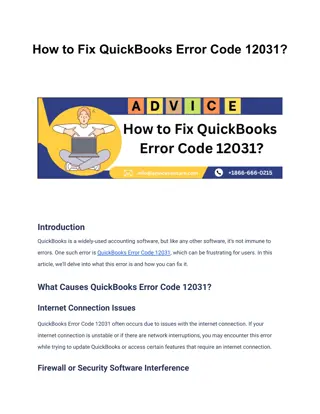
How to Delete a Deposit in QuickBooks
How to Delete a Deposit in QuickBooksnAccurate financial records are crucial for any business. In QuickBooks, deposits can occasionally be entered incorrectly. To delete a deposit, first, back up your data. Then, navigate to the Banking menu, select Make Deposits, and locate the deposit. Once found, click Delete Deposit and confirm. This action will update your financial reports and bank reconciliation. Always double-check entries and maintain organized records to prevent future errors. For more detailed guidance, consult QuickBooks support.n// /delete-a-deposit-in-qu
Download Presentation

Please find below an Image/Link to download the presentation.
The content on the website is provided AS IS for your information and personal use only. It may not be sold, licensed, or shared on other websites without obtaining consent from the author. If you encounter any issues during the download, it is possible that the publisher has removed the file from their server.
You are allowed to download the files provided on this website for personal or commercial use, subject to the condition that they are used lawfully. All files are the property of their respective owners.
The content on the website is provided AS IS for your information and personal use only. It may not be sold, licensed, or shared on other websites without obtaining consent from the author.
E N D
Presentation Transcript
How to Delete a Deposit in QuickBooks How to Delete a Deposit in QuickBooks Keeping your financial records accurate is crucial for any business, big or small. QuickBooks, a widely-used accounting software, helps manage these records efficiently. However, mistakes happen, and sometimes you need to delete a deposit. Whether it's a duplicate entry, an incorrect amount, or a simple error, knowing how to correct these mistakes is essential. In this article, we'll walk you through the process of deleting a deposit in QuickBooks. Understanding Deposits in QuickBooks What Constitutes a Deposit? A deposit in QuickBooks is a recorded transaction that represents money received by your business, such as customer payments, loan proceeds, or other receipts. Common Scenarios for Deposits Deposits can be recorded from sales receipts, invoices, or other income sources. Each deposit impacts your financial records and bank reconciliation. Impact of Deposits on Financial Records
Deposits affect your cash flow, financial reports, and overall accounting accuracy. Incorrect deposits can lead to discrepancies in your books. Reasons for Deleting a Deposit Duplicate Entries Sometimes, deposits are entered more than once, leading to inflated income records. Incorrect Amounts Errors in the deposited amounts can throw off your accounting balance. Erroneous Deposits Occasionally, deposits are recorded that shouldn't be, such as personal transactions mistakenly entered as business income. Reconciliation Errors Misrecorded deposits can create problems during bank reconciliation, where your QuickBooks records don't match your bank statements. Precautions Before Deleting a Deposit Backup Your QuickBooks Data Always create a backup before making significant changes to ensure you can restore your data if something goes wrong. Verify the Necessity of Deletion Double-check that deletion is the best solution. Sometimes, editing the deposit might be a better option. Check for Related Transactions Ensure there are no linked transactions that could be affected by deleting the deposit. Step-by-Step Guide to Delete a Deposit
Accessing QuickBooks Open QuickBooks and log in to your account. Navigating to the Deposits Section Go to the Banking menu, then select Make Deposits. Locating the Specific Deposit In the Make Deposits window, use the Date field and other filters to find the deposit you want to delete. Deleting the Deposit Once located, select the deposit and click on Delete Deposit. Detailed Steps with Screenshots (Hypothetical) Step 1: Open QuickBooks and Login Launch QuickBooks and enter your login credentials. Step 2: Go to the Banking Menu Navigate to the Banking menu at the top of the screen. Step 3: Select Make Deposits Choose the Make Deposits option from the dropdown menu. Step 4: Find the Deposit to Delete Use the Date field and other filters to identify the specific deposit. Step 5: Delete the Deposit Select the deposit and click Delete Deposit, then confirm the deletion. What Happens After Deleting a Deposit?
Impact on Bank Reconciliation Deleting a deposit will remove it from your bank reconciliation, potentially resolving discrepancies. Effects on Financial Reports The deletion will adjust your financial reports to reflect the corrected data. Adjustments in Accounts Accounts affected by the deleted deposit will be updated to show the changes. Common Issues and Troubleshooting Deposit Not Found If you can't locate the deposit, ensure you're searching within the correct date range and filters. Error Messages If you encounter error messages, check QuickBooks support for specific solutions. Reconciliation Discrepancies After deletion, re-run your bank reconciliation to ensure accuracy. Reversing a Deletion Restoring from a Backup If you've made an error by deleting a deposit, you can restore your QuickBooks data from a backup. Re-entering the Deleted Deposit Manually re-enter the deposit if necessary, ensuring all details are correct. Adjusting Related Transactions
Review and adjust any related transactions to maintain accurate records. Best Practices for Managing Deposits Regularly Review Financial Records Frequent reviews can help catch errors early. Consistent Reconciliation Processes Regular bank reconciliation ensures your records match your bank statements. Accurate Data Entry Double-check entries to prevent mistakes. Tips for Avoiding Deposit Errors Double-Check Entries Before finalizing deposits, verify all details for accuracy. Use QuickBooks Tools Effectively Utilize QuickBooks features like bank feeds to minimize manual entry errors. Maintain Organized Records Keep detailed and organized records to streamline financial management. FAQs About Deleting Deposits in QuickBooks Can Deleted Deposits Be Recovered? Yes, if you have a recent backup, you can restore your QuickBooks data. How to Avoid Duplicate Deposits? Regularly review your entries and use bank feeds to ensure accuracy.
What to Do if a Deposit is Missing? Check your filters and date range, and ensure the deposit was saved correctly. How Often Should I Back Up My QuickBooks Data? It's advisable to back up your data daily or after significant changes. Is It Better to Edit or Delete an Incorrect Deposit? If possible, editing is usually better to maintain transaction history and minimize disruptions. Conclusion Accurate financial records are the backbone of any business, and QuickBooks is a powerful tool to help manage these records. However, mistakes can happen, and knowing how to correct them is vital. By following the steps outlined in this guide, you can confidently delete deposits in QuickBooks when necessary, ensuring your records remain precise and reliable. Call to Action Explore the features of QuickBooks to manage your finances effectively, engage with QuickBooks support for any issues, and stay updated with tutorials to make the most out of your accounting software. https://www.adviceventure.com/delete-a-deposit-in-quickbooks/ https://www.adviceventure.com/ Email: info@adviceventure.com +18666660215






















